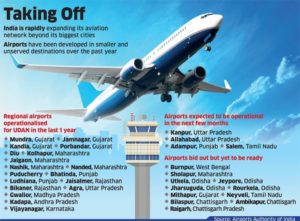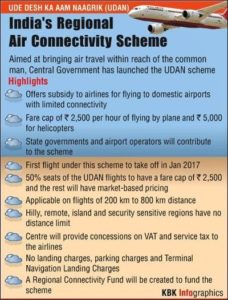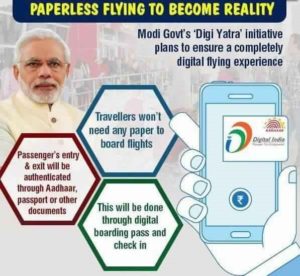CONNECTING THE COUNTRY: AVIATION INFRASTRUCTURE: Article Analysis
Introduction:

- India is the world’s fastest growing domestic aviation market, and has posted the fastest full year growth rate for three years in a row now.India’s Revenue Passenger Kilometre (RPK) growth of 17.5% was higher than the global average growth of 7% in 2017.At USD 16 billion, India’s aviation market is currently the 9th largest in the world and is projected to be the 3rd largest by 2020, and largest by 2030.More than 80 international airlines connecting to over 40 countries.
Why Indian Aviation sector is one of the best:
- India is projected to be the third largest aviation market by 2020, and the largest by 2030.
- The Indian aviation sector is likely to see investments totalling USD 15 billion during 2016-2020 of which USD 10 billion is expected to come from the private sector.
- Airport Authority of India (AAI) plans to revive and operationalize around 50 airports in India over the next 2 years to improve regional and remote air connectivity.
- Growth in aviation is also increasing demand for MRO (maintenance, repair and overhaul) facilitie
- Greater focus on infrastructure development – increasing liberalization – Open Sky Policy; AAI driving modernization of airports and Air & Navigation Systems. Five international airports (Delhi, Mumbai, Cochin, Hyderabad, Bengaluru) are operational under Public Private Partnership (PPP) mode.
- Enhanced Skill Development – Clear focus to leverage India’s human capital potential and create job opportunities.
- Innovation and Technology – Launched GPS Aided Geo Augmented Navigation (GAGAN): India’s first satellite based navigation system; NO Objection Certificate Application System (NOCAS): streamlines online process of timely NOC for height clearances of buildings around airports; E-Governance for Civil Aviation (eGCA): online delivery of 162 licensing and regulatory processes of DGCA.
Statistics:
- Domestic passenger traffic crossed the 100 million mark in 2017, reaching 106 million in the January to November period.India is the fastest growing aviation market and is expected to cater to 478 million passengers by 2036.
- India is one of the least penetrated air markets in the world with 0.04 trips per capita per annum as compared to 0.3 in China and more than 2 in the USA (2016).
Government Policies
- UDAN (‘Ude Desh ka Aam Naagrik’): is a first-of-its-kind scheme globally to stimulate regional connectivity through a market-based mechanism.

Pros:
- It could lead to development of smaller cities as faster air connectivity will attract infrastructure & investment
- It could ease passenger pressure from Railways & Roads.
- It may provide major boost to Tourism industry in India
- Smaller Airlines could successfully compete with bigger airlines.
- Moreover, of the 35 crore middle class citizens, only 8 cr people fly. Capping of fares, enhancing connectivity will lead to an increase in the number of citizens who can fly and can take some burden off railways
- It will give impetus to India’s ambition of becoming third largest aviation market by 2020
Cons:
- Administration of VGF would require scrutiny of airlines balance sheet which would be a messy process. It has the potential of becoming another hotbed for controversy
- Vgf would result in additional subsidy burden at a time when economic survey argued in favour of removing subsidies for the rich
- Subsidy based regime would be impacted by the vagaries of price changes in oil prices
- Capping of fares (1200 for half hour, 2500 for an hour) is criticized as airlines argue that it should be based on demand/supply
- Airports in many Tier 2 and Tier 3 cities do not have big runways, so they can’t take regular aircraft. That means airlines will need to induct smaller aircraft for short take-offs and landings. Such aircraft needs specialised crew. India produces 200 to 300 pilots every year, and it’s safe to say that training specialised crew will take time.
National Civil Aviation Policy 2016 – Vision, mission and Objectives:
- Vision: To create an eco-system to make flying affordable for the masses and to enable 30 crore domestic ticketing by 2022 and 50 crore by 2027, and international ticketing to increase to 20 crore by 2027. Similarly, cargo volumes should increase to 10 million tonnes by 2027.
- Mission: Provide safe, secure, affordable and sustainable air travel for passengers and air transportation of cargo with access to various parts of India and the world.
Objectives
- Establish an integrated eco-system which will lead to significant growth of civil aviation sector, which in turn would promote tourism, increase employment and lead to a balanced regional growth.
- Ensure safety, security and sustainability of aviation sector through the use of technology and effective monitoring.
- Enhance regional connectivity through fiscal support and infrastructure development.
- Enhance ease of doing business through deregulation, simplified procedures and e-governance.
- Promote the entire aviation sector chain in a harmonised manner covering cargo, MRO, general aviation, aerospace manufacturing and skill development.
Air Navigation Services (ANS)
- AAI is ranked among the top ANS providers in the world. Upgradation and modernisation of ANS in India is in line with global trends. With the launch of GAGAN, India has become the fourth country in the world to use satellite-based navigation system.
Aeronautical ‘Make in India’
- MoCA will be nodal agency for developing commercial aero-related manufacturing and its eco-system in India.
- MoCA and MoD will work together to ensure that commercial aeromanufacturing is covered under defence offsets requirements.
- MoCA will encourage Indian carriers to consolidate their future demand for commercial aircraft.
- The government will encourage global OEMs for establishment of aircraft assembly plant in India along with its ancillary industries.
- Area where aero-manufacturing takes place will be notified as SEZ after following the due process. The government will provide fiscal and monetary incentives and fast-track clearances to global OEMs and their ancillary suppliers.
- In case the cost of made-in-India aircraft and components work out to be higher than those supplied from their original sources, the government will consider an incentive package to nullify the cost differential.
Sustainable aviation:
- MoCA will strive to develop a sustainable Indian aviation industry. It will work with DGCA, Ministry of Environment, Forest and Climate Change and industry stakeholders to develop an appropriate action plan.
- MoCA will strengthen policy guidelines on energy conservation, sustainable practices, improvements in emission measurement and information dissemination; training and awareness building.
- MoCA will pursue limitation of CO2 emission in Indian aviation in coordination with ICAO under the principles and provisions of the United Nations Framework Convention on Climate Change (UNFCCC) and its Paris agreement.
- MoCA will strive to optimise Flexible Use of Airspace (FUA) in consultation with Ministry of Defence.
- All equipment operating within the airport environment will be in compliance with latest emission norms .
- Ground handling vehicle will use alternative fuels that can provide significant Local Air Quality (LAQ) emission benefits compared with petrol and diesel equipment. Options include LPG/ CNG vehicles, low emissions vehicles (LEV), hydrogen vehicles, and electric vehicles.
- All airports should undertake energy audit and adopt an energy conservation plan. All greenfield airports should have a concrete plan of energy efficiency and conservation. Airports should also have their own waste management facilities for solid and liquid waste.
Aviation and Tourism:
- The Government will promote the use of seaplanes for growth of tourism and regional connectivity along India’s 7,500 km coastline.
- Seaplanes shall also be permitted to fly from point to point without prior ATC clearance in airspace below 5000ft, outside the controlled air space, Temporary Segregated Areas (TSAs) and Temporary Restricted Areas (TRAs) and intimating the following information to the nearest ATC: Point of Origin, Destination, Level, Expected Time of departure (ETD), Expected Time of Arrival (ETA) and the duration of flight.
- MOCA will promote growth of General Aviation and Aero-sports activities with regulatory regime commensurate with the type of operations or aircraft in line with international best practices.
Digi-Yatra
- The Ministry of Civil Aviation is adding a Digital experience for Air Travellers through DigiYatra Platform. The ‘DigiYatra’ is an industry-led initiative co-ordinated by the Ministry in line with the Digital India’s vision to transform the nation into a digitally empowered society.
- Digi Yatra – Digital processing of passengers at the airports. Passengers will be automatically processed based on facial recognition system at check points like; Entry point check, Entry in to Security Check, Aircraft Boarding, Additionally this will also facilitate self-Bag Drop and Check-in, using facial recognition to identify pax and data recall. Digi Yatra will facilitate paperless travel and avoid identity check at multiple points.
Benefits:
- Passengers need not show boarding pass or ID at multiple check points.
- Minimum human intervention. Less queuing time.
- The security is enhanced as the system will map the passenger with the PNR. Only bona fide passenger will be allowed entry at every check point.
- Airport operator will have real time information on Passenger load and resource planning becomes better.
- Airlines will be benefitted by knowing the passenger position in the airport.
- Airport throughput will be enhanced.
Factors contributing to the growth of the aviation sector:
- From an over-regulated and under-managed sector, the aviation industry in India has now changed to a more open, liberal and investment-friendly sector, especially after 2004. The civil aviation sector in India has moved into a new era of expansion. Some major factors contributing to this are:
- Higher household incomes
- Strong economic growth
- Entry of low cost carriers (LCC)
- Increased FDI inflows in domestic airlines
- Increased tourist inflow
- Surging cargo movement
- Cutting edge information technology (IT) interventions
- Focus on regional connectivity
- Modern airports
- Sustained business growth and
- Supporting Government policies
Some Major Threats:
- A global economic slowdown negatively impacts leisure, optional and business travel.
- The continuous rise in the price of fuel is a major threat.
- A terrorist attack anywhere in the world can negatively impact air travel.
- Government intervention can lead to new costly rules.
- Operation of many airlines
Problems faced by the aviation sector:
- High operational costs
- High cost of aviation turbine fuel
- High service tax and other charges
- Shortage of maintenance facilities
- High foreign exchange rate
- Competition from foreign airlines
- Congestion at airports
- Lack of qualified pilots and technical manpower etc.

The Way Forward:
- The launching of the new airlines can be an aviation boom in the country as it will lead to an increase in the number of flights, lower prices, more demand for ground staff and trained crew, including a rise in finance and leasing activities.
- However, the real challenge of the Indian aviation industry is to manage the unprecedented growth of air traffic with safety. The increase in air traffic has raised the demand for aircrafts. But at the same time, it has also posed a problem of modernising the airport and air navigation infrastructure so that safe, efficient and orderly operations are ensured. There is an urgent need to study the causes of the issues and address them so as not to obstruct the growth path of the aviation sector.
- And we should remember that even today, access to aviation is still a distant dream for the poor and the lower middle class sections of its vast population.
- So there is a large untapped potential for growth in the industry as well. It is necessary for the stakeholders to engage and collaborate with the policy-makers to implement efficient and rational decisions that will shape the future of the aviation industry. With the right policies and a continued focus on cost, quality and passenger interests, India would definitely be able to realise its vision of becoming the third largest aviation market by 2020.











